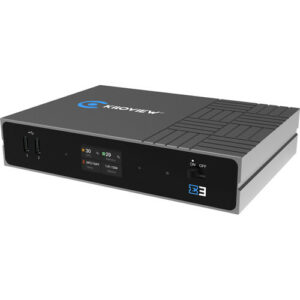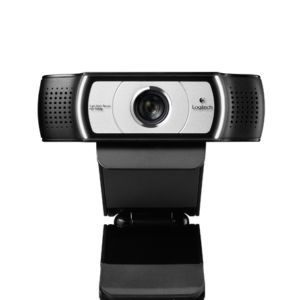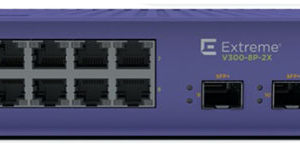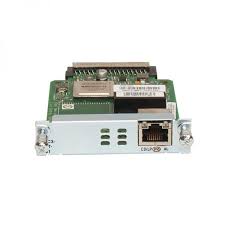Cisco VWIC2-1MFT-T1/E1 2nd Gen 1 Port MFT Voice WAN Interface Card for 1721, 1751 and 1760, Modular Access Routers, 2600XM Multiservice Router, 2691 Multiservice Platform, 3662 Telco Versatile DCN Access Platform, 3725 and 3745 Multiservice Routers, and the 1841, 2801, 2811, 2821, 2851, 3825, and 3845 Integrated Services Routers. – New Pull
Cisco VWIC2-1MFT-T1/E1 2nd Generation 1 Port Multiflex Trunk VoiceWide area network Interface Card for 1721, 1751 and 1760, Modular Access Routers, 2600XM Multiservice Router, 2691 Multiservice Platform, 3662 Telco Versatile DCN Access Platform, 3725 and 3745 Multiservice Routers, and the 1841, 2801, 2811, 2821, 2851, 3825, and 3845 Integrated Services Routers. – New Pull
The Cisco ® Second-generation 1- and 2-port T1/E1 Multiflex Trunk Voice/WAN Interface (MFT VWIC2s) support data and voice applications on the Cisco 1721 (data only), 1751 and 1760 Modular Access Routers, the Cisco 2600XM Multiservice Router, the Cisco 2691 Multiservice Platform, the Cisco 3662 Telco Versatile DCN Access Platform, the Cisco 3725 and 3745 Multiservice Routers, and the Cisco 1841 (data only), 2801, 2811, 2821, 2851, 3825, and 3845 Integrated Services Routers. The Cisco MFT VWIC2 combines WAN-interface-card (WIC) and voice-interface-card (VIC) functions to provide unparalleled flexibility, versatility, and investment protection through its many uses. Customers who choose to integrate data and voice in multiple steps preserve their investment in a T1/E1 WAN interface because the Cisco MFT VWIC2 cards can be reused in packet voice applications.
The Cisco MFT VWIC2 interface cards add numerous improvements over the Cisco 1- and 2-port T1/E1 Multiflex Voice/WAN Interface Cards (MFT VWICs). The MFT VWIC2 cards have an onboard slot for a Cisco MFT Dedicated Echo Cancellation (ECAN) Module offering an enhanced echo-cancellation capability for demanding network conditions. The T1/E1 MFT VWIC2 cards support both T1 and E1, providing additional flexibility in configuring the Cisco MFT VWIC2s for supporting T1, fractional T1, E1, and fractional E1 for both voice and WAN applications. All MFT VWIC2 modules now include the drop-and-insert multiplexing capability, which eliminates costly external third-party channel service units/data service units (CSUs/DSUs) and drop-and-insert multiplexers. The Cisco 2-port MFT VWIC2s also can enable each port to be clocked from independent clock sources for data applications. This independent clocking capability is not supported for voice applications or with the Cisco ATM/Voice Advanced Integration Modules.
The Cisco MFT VWIC2 cards can either be inserted into the WIC, VWIC and high-speed WIC (HWIC) slots on the supported Cisco 1721, 1751, 1760, 1841, 2600XM, 2691, 2801, 2811, 2821, 2851, 3662, 3725, 3745, 3825, and 3845 access routers, or they can be used in the VWIC slot(s) on the Digital T1/E1 Packet Voice Trunk Network Module (NM-HDV), IP Communications High-Density Digital Voice/Fax Network Modules (NM-HDV2), IP Communications High-Density Digital Voice NM with 1 T1/E1 (part number NM-HDV2-1T1/E1), IP Communications High-Density Digital Voice NM with 2 T1/E1, 2 slot IP Communications Enhanced Voice/Fax Network Modules, 2 WAN Card Slot Network Module, 1 10/100 Ethernet 1 4/16 Token Ring 2 WAN Card Slot NM, 1 10/100 Ethernet 2 WAN Card Slot Network Module, and 2 10/100 Ethernet 2 WAN Card Slot Network Module when used with a supported access router.
The Cisco MFT VWIC2 cards are offered in single- and dual-port versions, which can be used and then redeployed as network requirements change, thereby addressing several applications:
- T1/E1 data—The Cisco 1- and 2- port T1/E1 MFT VWIC2 versions act as a WIC, supporting T1, fractional T1, E1, (including structured G.703 with G.704 framing), fractional E1, and E1structured G.703 applications. To simplify remote management, these MFT VWIC2 cards integrate a fully managed DSU/CSU for T1 deployments and a fully managed DSU for E1 deployments.
- E1/G.703 data—The Cisco 1- and 2- port G.703 MFT VWIC2 versions act as a WIC, supporting T1, fractional T1, E1 (including structured G.703 with G.704 framing), fractional E1, and unstructured E1 (G.703) applications. To simplify remote management, the G.703 version includes a fully managed DSU. The G.703 versions also support all the capabilities on the T1/E1 versions.
- T1/E1 packet voice—The Cisco 1- and 2- port T1/E1 MFT VWIC2 (voice and WAN) versions act as a VIC, supporting packet voice applications by providing T1, fractional T1, E1, and fractional E1 connections to private branch exchanges (PBXs) and central offices, thereby enabling new services and reducing voice and fax toll charges.
- Mixed data and packet voice—The Cisco MFT VWIC2 interface cards can simultaneously support both data and voice, reducing the complexity and number of network components and facilitating a graceful migration to bandwidth-efficient packet voice.
- Mixed data and packet voice with drop and insert—The Cisco MFT VWIC2 cards can be deployed as a T1/E1 drop-and-insert multiplexer with integrated DSUs/CSUs, reducing the complexity of the network and the cost of the central-office ports by efficiently combining time-division multiplexing (TDM) voice (PBX), IP voice, and data on the same trunks. Note the Cisco 1721, 1751 and 1760 support drop and insert between two ports over a single VWIC2 card while Cisco 2800 and 3800 ISR routers supports drop and insert between two ports over a single VWIC2 card and two ports over two different VWICs.
KEY BENEFITS
Reduces Networking Lifecycle Costs
Maximizes System Resources
- Increases T1/E1 port density on the supported Cisco 1700, 1800, 2600, 2800, 3600, 3700, and 3800 access routers—up to four T1/E1 connections with an integrated CSU/DSU in a single network-module slot or up to two T1/E1 connections in a single WIC slot
- Offers easy migration to bandwidth-efficient packet voice, enabling new services
Customers who choose to integrate data and voice in stages to preserve their investment in WAN interfaces. For example, the Cisco MFT VWIC2 can support data-only applications as a WAN interface, and then be reused to integrate data and voice with the drop-and-insert multiplexer function or configured to support packetized voice (voice over IP [VoIP] or voice over Frame Relay [VoFR]) when installed in the Digital T1/E1 Packet Voice Trunk Network Module (NM-HDV), 2 slot IP Communications Enhanced Voice/Fax Network Module (NM-HD-2VE), or IP Communications High-Density Digital Voice/Fax Network Module (NM-HDV2), IP Communications High-Density Digital Voice NM with 1 T1/E1 (part number NM-HDV2-1T1/E1), IP Communications High-Density Digital Voice NM with 2 T1/E1 (part number NM-HDV2-2T1/E1).
APPLICATIONS
Packet Voice Solutions: PBX and Central-Office Connectivity
The Cisco MFT VWIC2 interface cards, through its digital T1/E1 ports, supply PBX and public-switched-telephone-network (PSTN) connectivity for the Digital T1/E1 Packet Voice Trunk Network Module (NM-HDV), 2 slot IP Communications Enhanced Voice/Fax Network Modules (NM-HD-2VE), IP Communications High-Density Digital Voice/Fax Network Modules (NM-HDV2), IP Communications High-Density Digital Voice NM with 1 T1/E1 (part number NM-HDV2-1T1/E1), IP Communications High-Density Digital Voice NM with 2 T1/E1 (part number NM-HDV2-2T1/E1), and access routers with on-board VIC/WIC/HWIC slots. The NM-HDV, NM-HD-2VE, NM-HDV2, NM-HDV2-1T1/E1, NM-HDV2-2T1/E1, and access routers support H.323-, Session Initiation Protocol (SIP)-, Media Gateway Control Protocol (MGCP)-, and Skinny Client Control Protocol (SCCP)-based VoIP-, FRF.11-, and FRF.12-based VoFR, and ATM Adaption Layer 5 (AAL5)-based voice-over-ATM (VoATM) industry standards.
Note: For each of these packet voice applications (VoIP, VoFR, or VoATM), an appropriate WIC also is required.
 TP-LINK BROADBAND ROUTER W/4 P
1 × AED80.00
TP-LINK BROADBAND ROUTER W/4 P
1 × AED80.00  C1760nw Standard Yield Black Toner Cartridge (700 pages*)
1 × AED259.00
C1760nw Standard Yield Black Toner Cartridge (700 pages*)
1 × AED259.00  DIR-100/E DSL/Cable 10/100Mbps WAN & 4 10/100Mbps Switch ports
1 × AED99.00
DIR-100/E DSL/Cable 10/100Mbps WAN & 4 10/100Mbps Switch ports
1 × AED99.00  Kiloview E3 HDMI & SDI Dual Channel Video Encoder
1 × AED2,299.00
Kiloview E3 HDMI & SDI Dual Channel Video Encoder
1 × AED2,299.00  Antennas Antenna Connector
1 × AED149.00
Antennas Antenna Connector
1 × AED149.00  LOGITECH WEBCAM C930e with HD 1080p Video and 90-degree Field of View
1 × AED599.00
LOGITECH WEBCAM C930e with HD 1080p Video and 90-degree Field of View
1 × AED599.00  Extreme Networks ExtremeSwitching V300-8P-2X Edge Switch
1 × AED8,399.00
Extreme Networks ExtremeSwitching V300-8P-2X Edge Switch
1 × AED8,399.00  Cisco NM-1E2W Network Module
1 × AED699.00
Cisco NM-1E2W Network Module
1 × AED699.00  04 3550600
04 3550600 052 7036860
052 7036860






There are no reviews yet.